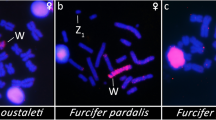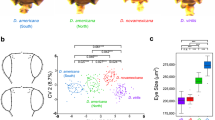Abstract
Chromosomal organization is sufficiently evolutionarily stable that large syntenic blocks of genes can be recognized even between species as distantly related as mammals and puffer fish (450 million years (Myr) of divergence)1,2,3,4,5,6,7. In Diptera, the gene content of the X chromosome and the autosomes is well conserved: in Drosophila more than 95% of the genes have remained on the same chromosome arm in the 12 sequenced species (63 Myr of divergence, traversing 400 Myr of evolution)2,4,6, and the same linkage groups are clearly recognizable in mosquito genomes (260 Myr of divergence)3,5,7. Here we investigate the conservation of Y-linked gene content among the 12 sequenced Drosophila species. We found that only a quarter of the Drosophila melanogaster Y-linked genes (3 out of 12) are Y-linked in all sequenced species, and that most of them (7 out of 12) were acquired less than 63 Myr ago. Hence, whereas the organization of other Drosophila chromosomes traces back to the common ancestor with mosquitoes, the gene content of the D. melanogaster Y chromosome is much younger. Gene losses are known to have an important role in the evolution of Y chromosomes8,9,10, and we indeed found two such cases. However, the rate of gene gain in the Drosophila Y chromosomes investigated is 10.9 times higher than the rate of gene loss (95% confidence interval: 2.3–52.5), indicating a clear tendency of the Y chromosomes to increase in gene content. In contrast with the mammalian Y chromosome, gene gains have a prominent role in the evolution of the Drosophila Y chromosome.
This is a preview of subscription content, access via your institution
Access options
Subscribe to this journal
Receive 51 print issues and online access
$199.00 per year
only $3.90 per issue
Buy this article
- Purchase on Springer Link
- Instant access to full article PDF
Prices may be subject to local taxes which are calculated during checkout



Similar content being viewed by others
Accession codes
Data deposits
Nucleotide sequence accession numbers are listed in the Supplementary Information.
References
Aparicio, S. et al. Whole-genome shotgun assembly and analysis of the genome of Fugu rubripes . Science 297, 1301–1310 (2002)
Beverley, S. M. & Wilson, A. C. Molecular evolution in Drosophila and the higher diptera II. A time scale for fly evolution. J. Mol. Evol. 21, 1–13 (1984)
Zdobnov, E. M. et al. Comparative genome and proteome analysis of Anopheles gambiae and Drosophila melanogaster . Science 298, 149–159 (2002)
Tamura, K., Subramanian, S. & Kumar, S. Temporal patterns of fruit fly (Drosophila) evolution revealed by mutation clocks. Mol. Biol. Evol. 21, 36–44 (2004)
Yeates, D. K. & Wiegmann, B. M. The Evolutionary Biology of Flies 35 (Columbia Univ. Press, 2005)
Bhutkar, A., Russo, S. M., Smith, T. F. & Gelbart, W. M. Genome-scale analysis of positionally relocated genes. Genome Res. 17, 1880–1887 (2007)
Nene, V. et al. Genome sequence of Aedes aegypti, a major arbovirus vector. Science 316, 1718–1723 (2007)
Rice, W. R. Evolution of the Y sex chromosome in animals. Bioscience 46, 331–343 (1996)
Charlesworth, B. & Charlesworth, D. The degeneration of Y chromosomes. Phil. Trans. R. Soc. Lond. B 355, 1563–1572 (2000)
Bachtrog, D., Hom, E., Wong, K. M., Maside, X. & de Jong, P. Genomic degradation of a young Y chromosome in Drosophila miranda . Genome Biol. 9, R30 (2008)
Carvalho, A. B. et al. Y chromosome and other heterochromatic sequences of the Drosophila melanogaster genome: how far can we go? Genetica 117, 227–237 (2003)
Hoskins, R. A. et al. Sequence finishing and mapping of Drosophila melanogaster heterochromatin. Science 316, 1625–1628 (2007)
Ashburner, M., Golic, K. G. & Hawley, R. S. Drosophila: a Laboratory Handbook 2nd edn 607–639 (Cold Spring Harbour Laboratory Press, 2005)
Kennison, J. A. The genetic and cytological organization of the Y chromosome of Drosophila melanogaster . Genetics 98, 529–548 (1981)
Hackstein, J. H. & Hochstenbach, R. The elusive fertility genes of Drosophila: the ultimate haven for selfish genetic elements. Trends Genet. 11, 195–200 (1995)
Skaletsky, H. et al. The male-specific region of the human Y chromosome is a mosaic of discrete sequence classes. Nature 423, 825–837 (2003)
Sturtevant, A. H. & Novitski, E. The homologies of the chromosome elements in the genus Drosophila . Genetics 26, 517–541 (1941)
Gepner, J. & Hays, T. S. A fertility region on the Y chromosome of Drosophila melanogaster encodes a dynein microtubule motor. Proc. Natl Acad. Sci. USA 90, 11132–11136 (1993)
Carvalho, A. B., Lazzaro, B. P. & Clark, A. G. Y chromosomal fertility factors kl-2 and kl-3 of Drosophila melanogaster encode dynein heavy chain polypeptides. Proc. Natl Acad. Sci. USA 97, 13239–13244 (2000)
Carvalho, A. B., Dobo, B. A., Vibranovski, M. D. & Clark, A. G. Identification of five new genes on the Y chromosome of Drosophila melanogaster . Proc. Natl Acad. Sci. USA 98, 13225–13230 (2001)
Carvalho, A. B. & Clark, A. G. Birth of a new gene on the Drosophila Y chromosome. The 44th Annual Drosophila Research Conference, Philadelphia, USA. Abstract 318C, page 113 (The Genetics Society of America, 2003)
Vibranovski, M. D., Koerich, L. B. & Carvalho, A. B. Two new Y-linked genes in Drosophila melanogaster . Genetics 179, 2325–2327 (2008)
Carvalho, A. B. & Clark, A. G. Y chromosome of D. pseudoobscura is not homologous to the ancestral Drosophila Y. Science 307, 108–110 (2005)
Drosophila 12 Genomes Consortium Evolution of genes and genomes on the Drosophila phylogeny. Nature 450, 203–218 (2007)
Betran, E., Thornton, K. & Long, M. Retroposed new genes out of the X in Drosophila . Genome Res. 12, 1854–1859 (2002)
Emerson, J. J., Kaessmann, H., Betran, E. & Long, M. Extensive gene traffic on the mammalian X chromosome. Science 303, 537–540 (2004)
Sturgill, D., Zhang, Y., Parisi, M. & Oliver, B. Demasculinization of X chromosomes in the Drosophila genus. Nature 450, 238–241 (2007)
Graves, J. A. Sex chromosome specialization and degeneration in mammals. Cell 124, 901–914 (2006)
Murphy, W. J. et al. Novel gene acquisition on carnivore Y chromosomes. PLoS Genet. 2, e43 (2006)
Hurst, L. D. Is Stellate a relict meiotic driver? Genetics 130, 229–230 (1992)
Acknowledgements
We thank S. Kumar, P. O’Grady, T. Markow, A. J. Bhutkar, S. C. Vaz, E. Betran, A. A. Peixoto, P. H. Krieger and P. Paiva for comments on the manuscript and/or for sharing their unpublished results. We also thank T. Pinhão, A. Bastos and F. Krsticevic for help with the experiments, K. Krishnamoorthy for statistical advice and M. Fetchko for help with GenBank submission. This work was supported by Conselho Nacional de Desenvolvimento Científico e Tecnológico-CNPq, Coordenação de Aperfeiçoamento do Pessoal de Ensino Superior-CAPES, FAPERJ, FIC-NIH grant TW007604-02 (A.B.C.) and NIH grant GM64590 (A.G.C.).
Author information
Authors and Affiliations
Corresponding author
Supplementary information
Supplementary Information
This file contains Supplementary Discussions, Supplementary Methods, Supplementary Figures 1-11 with Legends, Supplementary Tables 1-5, Supplementary References and Supplementary Notes. (PDF 2733 kb)
Rights and permissions
About this article
Cite this article
Koerich, L., Wang, X., Clark, A. et al. Low conservation of gene content in the Drosophila Y chromosome. Nature 456, 949–951 (2008). https://doi.org/10.1038/nature07463
Received:
Accepted:
Published:
Issue Date:
DOI: https://doi.org/10.1038/nature07463
This article is cited by
-
De novo assembly of the olive fruit fly (Bactrocera oleae) genome with linked-reads and long-read technologies minimizes gaps and provides exceptional Y chromosome assembly
BMC Genomics (2020)
-
Multiple gene movements into and out of haploid sex chromosomes
Genome Biology (2017)
-
Convergent evolution of Y chromosome gene content in flies
Nature Communications (2017)
-
First report of Y-linked genes in the kissing bug Rhodnius prolixus
BMC Genomics (2016)
-
How to make a sex chromosome
Nature Communications (2016)
Comments
By submitting a comment you agree to abide by our Terms and Community Guidelines. If you find something abusive or that does not comply with our terms or guidelines please flag it as inappropriate.



